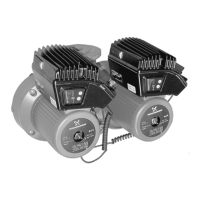133
6.6 Temperature influence
Can be set by means of the R100.
When this function is activated in proportional or
constant control mode, the setpoint for head will be
reduced according to the liquid temperature. It is
possible to set temperature influence to function at
liquid temperatures below 80°C or below 50°C.
These temperature limits are called T
max.
. The set-
point is reduced in relation to the head set (= 100%)
according to the characteristics below.
Fig. 11
In the above example, T
max.
= 80°C has been
selected. The actual liquid temperature T
actual
causes the setpoint for head to be reduced from
100% to H
actual
.
The temperature influence function requires:
• Proportional or constant-pressure control mode.
• The pump must be installed in the flow pipe.
• System with flow-pipe temperature control
(e.g. according to outdoor temperature).
Temperature influence is suitable in:
• systems with variable flows (e.g. two-pipe heating
systems), in which the activation of the tempera-
ture influence function will ensure a further reduc-
tion of the pump performance in periods with small
heating demands and consequently a reduced
flow-pipe temperature, and
• systems with almost constant flows (e.g. one-pipe
heating systems and underfloor heating systems),
in which variable heating demands cannot be reg-
istered as changes in the head (as is the case
with two-pipe heating systems). In such systems,
the pump performance can only be adjusted by
activating the temperature influence function.
Selection of T
max.
In systems with a dimensioned flow-pipe tempera-
ture of:
• up to and including 55°C, select T
max.
= 50°C,
• above 55°C, select T
max.
= 80°C.
6.7 Indicator lights
The two indicator lights are used for fault and operat-
ing indication.
For position on pump, see fig. 13, section 7.2 Control
panel.
Master pump indicator lights:
The functions of the master pump indicator lights
apply to both the master pump and the slave pump.
A fault in the slave pump will thus be indicated on the
master pump.
Slave pump indicator lights:
The green indicator light on the slave pump will flash
on and off 20 times per minute to indicate correct
communication with the master pump.
The indicator lights of the slave pump can be acti-
vated briefly by pressing a button on the slave pump
control panel. Fault indication will then only apply to
the slave pump.
Note: When the R100 remote control communicates
with the master pump, the red indicator light will flash
rapidly.
Functions of indicator lights:
See also section 8. Fault finding chart.
TM01 0626 1797
30%
100%
°CT
805020
H
H
Q
H
actual
T
actual
Indicator lights
DescriptionFault
(red)
Opera-
tion
(green)
Off Off
The electricity supply has
been switched off.
Off
Perma-
nently on
The pump is operating.
Off Flashing
The pump has been set to
stop.
Perma-
nently on
Off
The pump has stopped be-
cause of a fault. Restarting
will be attempted. (It may
be necessary to restart the
pump manually by resetting
the fault indication.)
Perma-
nently on
Perma-
nently on
The pump is operating, but
it has been stopped be-
cause of a fault.
Note: If there is no differ-
ential pressure or tempera-
ture sensor signal, the
pump will continue operat-
ing according to the max.
curve.
Perma-
nently on
Flashing
The pump has been set to
stop, but it has been
stopped because of a fault.

